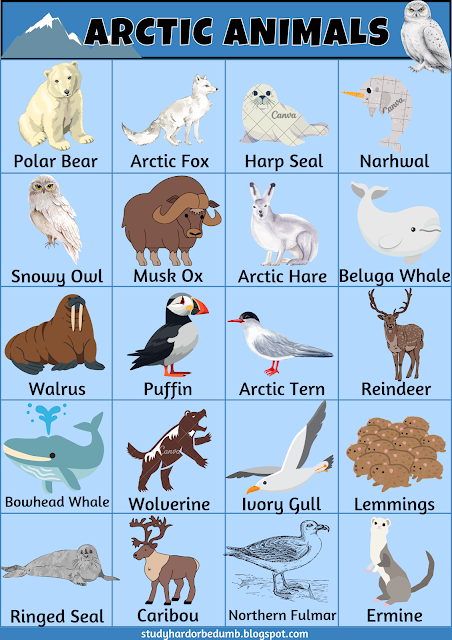Arctic Animals Vocabulary and General Knowledge I Learn new words, fun facts and common Phrases with Pictures
Notable Arctic Animals
- Polar Bear
- Arctic Fox
- Snowy Owl
- Harp Seal
- Narwhal
- Beluga Whale
- Arctic Hare
- Musk Ox
- Walrus
- Puffin
- Arctic Tern
- Reindeer
- Lemmings
- Ivory Gull
- Wolverine
- Bowhead Whale
- Ringed Seal
- Caribou
- Northern Fulmar
- Ermine
| Serial Number | Name of the Arctic Animal |
|---|---|
| 1 | Polar Bear |
| 2 | Arctic Fox |
| 3 | Snowy Owl |
| 4 | Harp Seal |
| 5 | Narwhal |
| 6 | Beluga Whale |
| 7 | Arctic Hare |
| 8 | Musk Ox |
| 9 | Walrus |
| 10 | Puffin |
| 11 | Arctic Tern |
| 12 | Reindeer |
| 13 | Lemmings |
| 14 | Ivory Gull |
| 15 | Wolverine |
| 16 | Bowhead Whale |
| 17 | Ringed Seal |
| 18 | Caribou |
| 19 | Northern Fulmar |
| 20 | Ermine |
Interesting Facts About Arctic Animals - Notable Species
- Polar bears are the largest land carnivores. Adult males can weigh up to 1,500 pounds (680 kg).
- Arctic foxes change the color of their fur with the seasons. Their fur is white in winter and brown in summer to blend with the surroundings.
- Snowy owls can travel great distances. They are known to migrate as far south as the northern United States during winter.
- Harp seals are excellent swimmers. They can dive to depths of over 1,200 feet (370 meters) and stay underwater for up to 15 minutes.
- Narwhals use their tusks for sensing the environment. The tusks have millions of nerve endings that can detect changes in the water.
- Beluga whales are known as the "canaries of the sea." They are highly vocal and use a wide range of sounds to communicate.
- Arctic hares live in groups for protection. These groups can include up to 100 individuals.
- Musk oxen have a unique defense mechanism. When threatened, they form a circle with their horns facing outward to protect the young.
- Walruses have a thick layer of blubber. This blubber can be up to 6 inches (15 cm) thick, keeping them warm in icy waters.
- Puffins are excellent divers. They can dive to depths of up to 200 feet (60 meters) in search of fish.
Cold as a polar bear's nose – Extremely cold.
Sly as a fox – Very cunning or clever.
Snow owl's wisdom – Someone who is very wise.
Harp seal's cry – A loud, plaintive cry.
Narwhal's journey – A long, adventurous journey.
Beluga's song – A melodious sound or voice.
Arctic hare's leap – A sudden, quick movement.
Musk ox's strength – Incredible strength.
Walrus's patience – Great patience and endurance.
Puffin's dive – A swift and efficient action.
Reindeer's trek – A long and arduous journey.
Lemming's leap – Following the crowd without thinking.
Ivory gull's cry – A distinctive, high-pitched call.
Wolverine's ferocity – Fierce and aggressive behavior.
Bowhead whale's song – A haunting, beautiful sound.
Ringed seal's agility – Exceptional agility and grace.
Caribou's migration – A regular, seasonal movement.
Northern fulmar's flight – A steady, unerring flight.
Ermine's stealth – Quiet and sneaky.
Snowy owl's watch – Vigilant and observant.
Fun Facts About Arctic Animals
- Polar bears have black skin under their white fur. This helps them absorb heat from the sun to stay warm.
- The Arctic fox has fur on the soles of its feet. This adaptation helps it keep warm and provides better traction on ice.
- Snowy owls are one of the heaviest owl species in North America. They can weigh up to 6.5 pounds (3 kg).
- Harp seals can hold their breath for up to 15 minutes underwater. This helps them evade predators and search for food.
- Narwhals are often called the "unicorns of the sea" due to their long tusks. These tusks are actually elongated teeth that can grow up to 10 feet (3 meters) long.
- Beluga whales can mimic human speech. They have been known to produce sounds similar to human voices.
- Arctic hares can run up to 37 mph (60 km/h). Their speed helps them escape from predators.
- Musk oxen have two layers of fur. The inner layer, called qiviut, is one of the warmest fibers in the world.
- Walruses use their tusks to help them climb out of the water and onto the ice. They also use them to break breathing holes in the ice.
- Puffins can flap their wings up to 400 times per minute. This allows them to "fly" underwater while hunting for fish.



Comments
Post a Comment